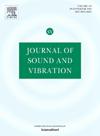Negating self-induced parametric excitation in capacitive ring-based MEMS Coriolis vibrating gyroscopes
IF 4.3
2区 工程技术
Q1 ACOUSTICS
引用次数: 0
Abstract
Rate sensing performance of ring-based capacitive Coriolis Vibratory Gyroscopes (CVGs) is degraded by the presence of imperfections and self-induced parametric excitation caused by electrostatic nonlinearities as the drive amplitude increases. This paper investigates the feasibility of using electrostatic forces to negate self-induced parametric excitation for a ring based CVG having 8 electrodes uniformly spaced inside and outside the ring. A mathematical model is developed to describe sensor dynamics under operating conditions and negation of self-induced parametric excitation is achieved by including additional parametric pumping voltages that generate electrostatic forces in antiphase with the self-induced parametric excitation. Numerical results are obtained for the rate sensitivity, bias rate and quadrature error of the sense output as the drive amplitude is increased and it is found that negating self-induced parametric excitation can enhance device performance under specific conditions by enabling nonlinear frequency matching. The proposed approach is more effective for larger electrode spans and improves the linearity of the rate sensing performance with drive amplitude. Numerical results are presented which include a comparison with results obtained using the Finite Element method to validate the proposed approach.

求助全文
约1分钟内获得全文
求助全文
来源期刊

Journal of Sound and Vibration
工程技术-工程:机械
CiteScore
9.10
自引率
10.60%
发文量
551
审稿时长
69 days
期刊介绍:
The Journal of Sound and Vibration (JSV) is an independent journal devoted to the prompt publication of original papers, both theoretical and experimental, that provide new information on any aspect of sound or vibration. There is an emphasis on fundamental work that has potential for practical application.
JSV was founded and operates on the premise that the subject of sound and vibration requires a journal that publishes papers of a high technical standard across the various subdisciplines, thus facilitating awareness of techniques and discoveries in one area that may be applicable in others.
 求助内容:
求助内容: 应助结果提醒方式:
应助结果提醒方式:


